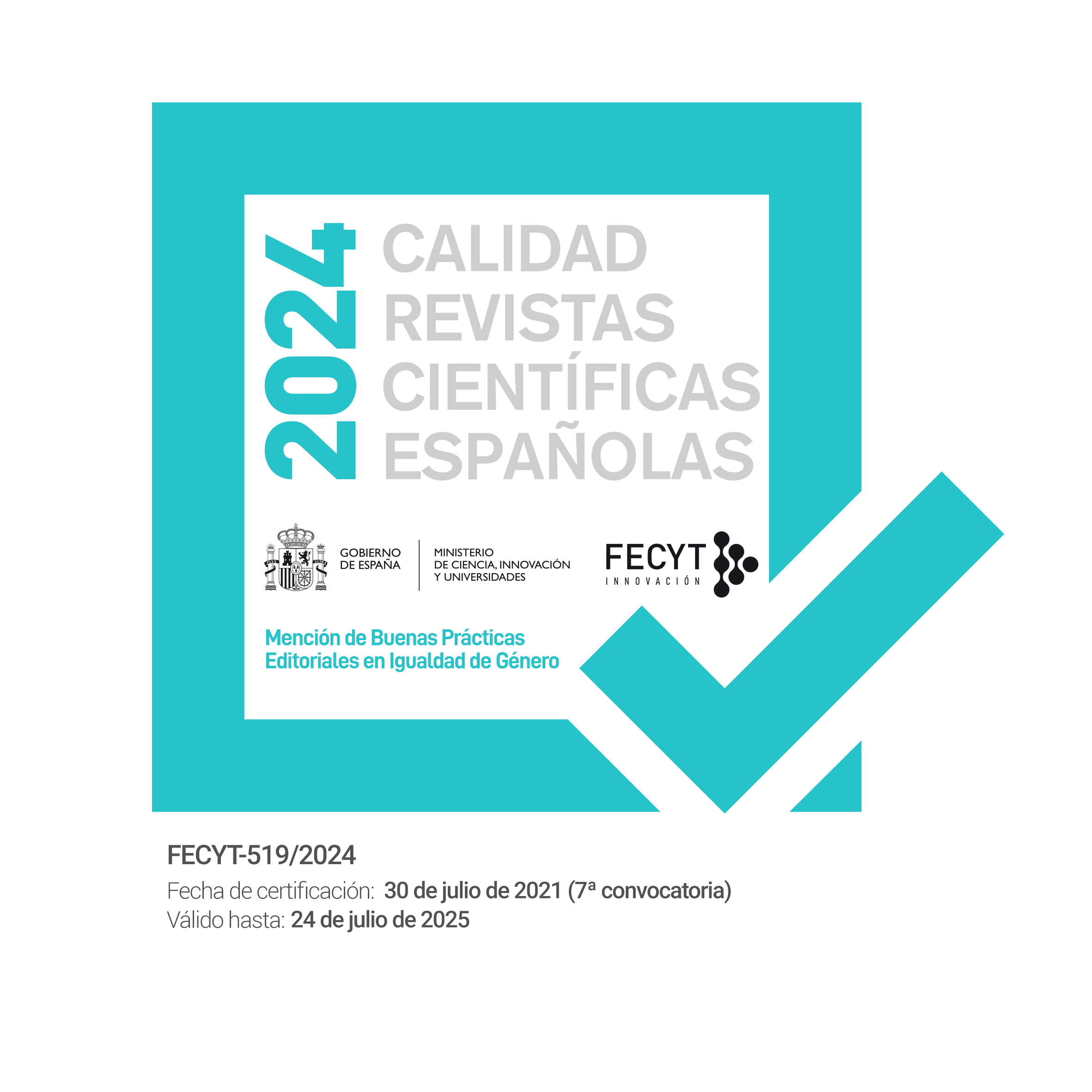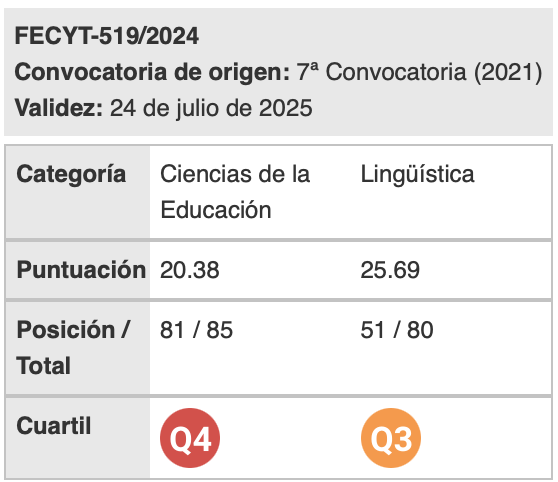Enhancing FL Learners' Perception of Non-native English Pronunciation with a Telecollaborative Project Work
Keywords:
Accent perception, Telecollaboration, Project Work, Non-native English, Global EnglishAbstract
This research aims to analyze the change of our students' opinion towards native and non-native English and their perception of non-native speakers’ pronunciation. To this purpose, telecollaborative project work was held with students from Universitat Politècnica de València (UPV), Spain, and the National Technical University of Ukraine “Igor Sikorsky” Kyiv Polytechnic Institute (KPI), Ukraine. Our students were divided into an experimental and a control group. Both groups completed two surveys before and after the telecollaborative project, and their progress was measured. The first survey enquired students about their perception of other non-native English accents (adapted from He & Li, 2009). In the second survey, students assessed the accent of other international students who were non-native of English (based on Bayard, Weatherall, Gallois & Pittam, 2001; and Zahn & Hopper, 1985). Results showed that students who had been in contact with other non-native speakers positively changed their perception of that variety of English. In conclusion, telecollaboration seems to be a valuable tool to develop cultural competence and avoid prejudices against non-native speakers.
Downloads
References
Anchimbe, E. A. (2006). The native-speaker fever in English language teaching (ELT): Pitting pedagogical competence against historical origin. Linguistik Online, 26 (1), 3-14. <https://bop.unibe.ch/linguistik-online/article/view/618> [01/01/2022].
Ballard, L. & Winke, P. (2017). Students Attitudes Towards English Teachers' Accents: The Interplay of Accent Familiarity, Comprehensibility, Intelligibility, Perceived Native Speaker Status, and Acceptability as a Teacher. In T. Isaacs & P. Trofimovich (Eds.), Second Language Pronunciation Assessment: Interdisciplinary Perspectives (pp. 121- 140). Blue Ridge Summit.
Bayard, D., Weatherall, A., Gallois, C. & Pittam, J. (2001). Pax Americana? Accent Attitudinal Evaluations in New Zealand, Australia, and America. Journal of Sociolinguistics, 5 (1), 22- 49. <https://onlinelibrary.wiley.com/doi/abs/10.1111/1467-9481.00136> [01/01/2022].
Bjorkqvist, K., Lagerspetz, K. M. J., & Kaukiainen, A. (1992). Do girls manipulate, and ¨ boys fight? Developmental trends regarding direct and indirect aggression. Aggressive Behavior, 18, 117–127. <https://onlinelibrary.wiley.com/doi/10.1002/1098-2337(1992)18:2%3C117::AID-AB2480180205%3E3.0.CO;2-3> [01/01/2022].
Bloomfield, L. (1927). Literate and illiterate speech. American speech, 2(10), 432-439. <https://doi.org/10.2307/451863> [01/04/2022].
Bradac, J. J. (1990). Language attitudes and impression formation. In H. Giles & W. P. Robinson (Eds.), Handbook of language and social psychology (pp. 387–412). Wiley.
Braine, G. (2010). Non-native speaker English teachers: Research, pedagogy, and professional growth. Routledge.
Bueno-Alastuey, M. C. (2011). Perceived benefits and drawbacks of synchronous voice-based computer-mediated communication in the foreign language classroom. Computer Assisted Language Learning, 24 (5), 419-432. <https://www.tandfonline.com/doi/abs/ 10.1080/09588221.2011.574639> [01/01/2022].
Bueno-Alastuey, M.C. (2013). Interactional feedback in synchronous voice-based computer-mediated communication: Effect of dyad. System, 41 (3), 543-559. <https://www.infona.pl/resource/bwmeta1.element.elsevier-0db1587a-3c45-34f9-8564-63963335f571> [01/01/2022].
Buss, A. H. (1961). Prejudice. In A. H. Buss, The psychology of aggression (pp. 245–265). John Wiley & Sons Inc.
Byram, M. (2006). Language teaching for intercultural citizenship: The European situation. The University of Auckland.
Canale, M., & Swain, M. (1980). Theoretical bases of communicative approaches to second language teaching and testing. Applied linguistics, 1(1), 1-47.Chomsky, N. (1965). Aspects of the theory of syntax. MIT Press. <http://www.uefap.com/tefsp/bibliog/ canale_swain.pdf> [01/04/2022].
Chomsky, N. (1965). Aspects of the theory of syntax. MIT Press.
Crystal, D. (2003). English as a global language. Ernst Klett Sprachen.
Cunha de Souza, L. E., Pereira, C. R., Camino, L., Souza de Lima, T. J., & Rosas-Torres, A. R. (2016). The legitimizing role of accent on discrimination against immigrants. European Journal of Social Psychology, 46 (5), 609-620. <https://repositorio.ul.pt/bitstream/10451/25705/1/ICS_CRPereira_legitimizing_ARI.pdf> [01/01/2022].
Cunningham, D. J., & Vyatkina, N. (2012). Telecollaboration for professional purposes: Towards developing a formal register in the foreign language classroom. Canadian modern language review, 68 (4), 422-450. <https://kuscholarworks.ku.edu/handle/ 1808/26363> [01/01/2022].
Derwing, T. M., J. M. Rossiter, and M. J. Munro (2002). Teaching native speakers to listen to foreign-accented speech. Journal of Multilingual and Multicultural Development, 23 (4), 245–259. <https://www.tandfonline.com/doi/abs/10.1080/ 01434630208666468> [01/01/2022].
Devine, P. G. (1989). Stereotypes and prejudice: Their automatic and controlled components. Journal of Personality and Social Psychology, 56, 5–18. <https://doi.org/10.1037/0022-3514.56.1.5?sid=semanticscholar> [01/01/2022].
Dooly, M. (2017). Telecollaboration. In C. A. Chapelle, & S. Sauro (eds.), The handbook of technology and second language teaching and learning (pp. 169-183). Wiley Blackwell.
Dovidio, J. F. (2001). On the nature of contemporary prejudice: The third wave. Journal of Social Issues, 57, 829–849. <https://spssi.onlinelibrary.wiley.com/doi/abs/10.1111/0022-4537.00244> [01/01/2022].
Ellis, R. (2003). Task-based language learning and teaching. Oxford University Press.
Greenbaum, S. (1986). English and a grammarian's responsibility: the present and the future. World Englishes, 5(2‐3), 189-195. <https://onlinelibrary.wiley.com/doi/abs/10.1111/j.1467-971X.1986.tb00725.x> [01/01/2022].
Guth, S., & Marini-Maio, N. (2010). Close encounters of a new kind: The use of Skype and Wiki in telecollaboration. In S. Guth & F. Helm (eds.), Telecollaboration 2.0 (pp. 413–427). Peter Lang.
Hansen, K., Rakić, T. & Steffens, C. M. (2014). When actions speak louder than words: Preventing discrimination of non-standard speakers. Journal of Language and Social Psychology, 33 (1), 68–77. <https://journals.sagepub.com/doi/abs/10.1177/ 0261927x13499761> [01/01/2022].
He, D. (2015). University students’ and teachers’ perceptions of China English and world Englishes: Language attitudes and pedagogic implications. The Asian Journal of Applied Linguistics, 2 (2), 65-76. <https://caes.hku.hk/ajal/index.php/ajal/article/view/129> [01/01/2022].
He, D., & Li, D. C. (2009). Language attitudes and linguistic features in the ‘China English’ debate. World Englishes, 28 (1), 70-89. <https://onlinelibrary.wiley.com/doi/abs/10.1111/j.1467-971X.2008.01570.x> [01/01/2022].
Heise, D. R. (1970). The Semantic Differential and Attitude Research. In Summers, G. F. (ed.) Attitude Measurement (pp. 235-253). Kershaw Publishing Company.
Helm, F. & Guth, S. (2010). The multifarious goals of telecollaboration 2.0: Theoretical and practical implications. In F. Helm and S. Guth (eds.), Telecollaboration 2.0: Languages, Literacies and Intercultural Learning in the 21st Century (pp. 69–106). Peter Lang.
Hidayah, B., Maulina, D., Shyahnaz, S. S., & Mahrita, E. (2020). Inter-Religious Hostility Development Scale: Concept, Validity, and Reliability. Advances in Social Science, Education and Humanities Research, 494, 69-80. <https://www.atlantis-press.com/proceedings/iciap-uipsur-19/125946648> [01/01/2022].
Hosoda, M., Stone-Romero, E. F., & Walter, J. N. (2007). Listeners’ cognitive and affective reactions to English speakers with standard American English and Asian accents. Perceptual and Motor Skills, 104, 307–326. <https://journals.sagepub.com/doi/10.2466/ pms.104.1.307-326> [01/01/2022].
Huang, L., Frideger, M., & Pearce, J. L. (2013). Political skill: Explaining the effects of non-native accent on managerial hiring and entrepreneurial investment decisions. Journal of Applied Psychology, 98, 1005–1017. <https://psycnet.apa.org/record/2013-28924-001> [01/01/2022].
Hultgren, A.K. (2020). Global English: From “Tyrannosaurus Rex” to “Red Herring”. Nordic Journal of English Studies, 19 (3), 10–34. <https://njes-journal.com/articles/abstract/10.35360/njes.574/> [01/01/2022].
Hymes D (1977). Foundations in Sociolinguistics: An ethnographic approach. London: Tavistock.
Jauregi, K., & Bañados, E. (2008). Virtual interaction through video-web communication: A step towards enriching and internationalizing learning programs. ReCALL, 20 (2), 183–207. <https://www.cambridge.org/core/journals/recall/article/abs/ virtual-interaction-through-videoweb-communication-a-step-towards-enriching-and-internationalizing-language-learning-programs/0FBF5F37F94B448DB3D2173AFB463895> [01/01/2022].
Jenkins, J. (2017). Not English but English-within-multilingualism. In New directions for research in foreign language education (pp. 63-78). Routledge.
Kirschner, L. L. (2015). Combining Skype with Blogging: A change to stop reinforcement of stereotypes in intercultural exchanges? The Eurocall Review, 23 (1), 24-30. <> [01/01/2022].
Kramsch, C. (2006). The multilingual subject. International Journal of Applied Linguistics, 16 (1), 97–110. <https://onlinelibrary.wiley.com/doi/abs/10.1111/j.1473-4192.2006.00109.x> [01/01/2022].
Kraut, R., and S. Wulff (2013). Foreign–accented speech perception ratings: a multifactorial case study. Journal of Multilingual and Multicultural Development, 34 (3), 249–63. <https://www.tandfonline.com/doi/abs/10.1080/01434632.2013.767340> [01/01/2022].
Low, E. L. (2015). Pronunciation for English as an international language: From research to practice. Routledge.
Major, R. C., Fitzmaurice, S. F., Bunta, F., & Balasubramanian, C. (2005). Testing the effects of regional, ethnic, and international dialects of English on listening comprehension. Language Learning, 55, 37–69. <https://squ.pure.elsevier.com/en/publications/ testing-the-effects-of-regional-ethnic-and-international-dialects-2> [01/01/2022].
Maum, R. (2002). Nonnative-English-speaking teachers in the English teaching profession. ERIC Clearinghouse on Languages and Linguistics.
McCambridge, L., & Saarinen, T. (2015). “I know that the natives must suffer every now and then”: Native/non-native indexing language ideologies in Finnish higher education. In S. Dimova, A.K. Hultgren & C. Jensen (eds.), English-medium instruction in European higher education (pp. 291-316). De Gruyter Mouton.
McKenzie, R. M. (2006). A Quantitative Study of the Attitudes of Japanese Learners toward Varieties of English Speech: Aspects of the Sociolinguistics of English in Japan. The University of Edinburgh.
Medgyes, P. (1992). Native or non-native: who's worth more?. ELT journal, 46(4), 340-349. <https://doi.org/10.1093/elt/46.4.340> [01/04/2022].
Moussu, L. (2002). English as a second language students' reactions to non-native English-speaking teachers. Brigham Young University. <https://eric.ed.gov/?id=ED468879>
Moussu, L. (2006). Native and non-native English-speaking English as second language teachers: Student attitudes, teacher self-perceptions, and intensive English administrator beliefs and practices. Purdue University. <https://eric.ed.gov/?id=ED492599>
Moussu, L. (2010). Influence of Teacher-Contact Time and Other Variables on ESL Students' Attitudes Towards Native- and Nonnative-English-Speaking Teachers. TESOL Quarterly, 44 (4), 746-768. <https://dx.doi.org/10.2307/27896762> [01/01/2022].
Newton J. (2016). Teaching English for Intercultural Spoken Communication. In W. Renandya, & H. Widodo (eds), English Language Teaching Today: English Language Education (pp. 161-177). Springer.
O'Dowd, R. (2018). From telecollaboration to virtual exchange: State-of-the-art and the role of UNICollaboration in moving forward. Research-publishing.net, Journal of Virtual Exchange, 1 (1), 1-23. <https://journal.unicollaboration.org/article/view/35567> [01/01/2022].
O’Rourke, B. (2005). Form-focused interaction in online tandem learning. CALICO, 22 (3), 433–466. <https://journal.equinoxpub.com/Calico/article/view/17273> [01/01/2022].
Paikeday, T. M. (1985). May I kill the native speaker?. Tesol Quarterly, 19(2), 390-395. <https://doi.org/10.2307/3586840> [01/04/2022].
Polisca, P. (2011). Language learning and the raising of cultural awareness through Internet telephony: A case study. The Language Learning Journal, 39 (3), 329–343. <https://www.tandfonline.com/doi/abs/10.1080/09571736.2010.538072> [01/01/2022].
Riney, T., Takagi, N, & Inutsuka, K. (2005). Phonetic parameters and perceptual judgments of accent in English by American and Japanese listeners. TESOL Quarterly, 39, 3, 441-466. <https://www.jstor.org/stable/3588489> [01/01/2022].
Ruscher, J. B. (2001). The social psychology of prejudiced communication. Guilford Press
Scherer Bassani, P., & Buchem, L. (2019). Virtual exchanges in higher education: developing intercultural skills of students across borders through online collaboration. Revista Interuniversitaria de Investigación en Tecnología Educativa, 6, 22-36. <https://revistas.um.es/riite/article/view/377771> [01/01/2022].
Segel-Karpas, D., & Ayalon, L. (2020). Loneliness and hostility in older adults: A cross-lagged model. Psychology and Aging, 35 (2), 169-176. <https://psycnet.apa.org/record/2019-66844-001> [01/01/2022].
Sifakis, N. C. & Sougari, A. M. (2005). Pronunciation Issues and EIL Pedagogy in the Periphery: A Survey of Greek State School Teachers' Beliefs. TESOL Quarterly, 39(3), 467-488. <https://onlinelibrary.wiley.com/doi/abs/10.2307/3588490> [01/01/2022].
Simons, G. & Charles D. (2018). Ethnologue: Languages of the World (Twenty-first edition). SIL International. <http://www.ethnologue.com>.
Smith, L. E., & Rafiqzad, K. (1979). English for cross-cultural communication: The question of intelligibility. Tesol Quarterly, 371-380. <https://www.jstor.org/stable/3585884> [01/01/2022].
Tomlinson, B. (2001). The inner voice: A critical factor in language learning. Journal of the Imagination in L2 Learning, 6, 26–33. <https://files.eric.ed.gov/fulltext/ED476596.pdf#page=28> [01/01/2022].
Tian, J., & Wang, Y. (2010). Taking language learning outside the classroom: Learners’ perspectives of eTandem learning via Skype. Innovation in Language Learning and Teaching, 4 (3), 181–197. <https://www.tandfonline.com/doi/abs/10.1080/ 17501229.2010.513443> [01/01/2022].
Widdowson (1994). The ownership of English. TESOL Quarterly 28(2). 377–389. <https://doi.org/10.2307/3587438> [01/04/2022].
Zahn, C. & Hopper, R. (1985). Measuring Language Attitudes: The Speech Evaluation Instrument. Journal of Language and Social Psychology, 4 (2), 113-123. <https://journals.sagepub.com/doi/10.1177/0261927X8500400203> [01/01/2022].
Downloads
Published
How to Cite
Issue
Section
License
Authors who publish with this journal agree to the following terms:
- Authors retain copyright and grant the journal right of first publication with the work simultaneously licensed under a Creative Commons Attribution License that allows others to share the work with an acknowledgement of the work's authorship and initial publication in this journal.
- Authors are able to enter into separate, additional contractual arrangements for the non-exclusive distribution of the journal's published version of the work (e.g., post it to an institutional repository or publish it in a book), with an acknowledgement of its initial publication in this journal.
- Authors are permitted and encouraged to post their work online (e.g., in institutional repositories or on their website) prior to and during the submission process, as it can lead to productive exchanges, as well as earlier and greater citation of published work (See The Effect of Open Access).

Revista de Lenguas para fines específicos is licensed under a Creative Commons Reconocimiento-NoComercial-SinObraDerivada 4.0 Internacional License.

























